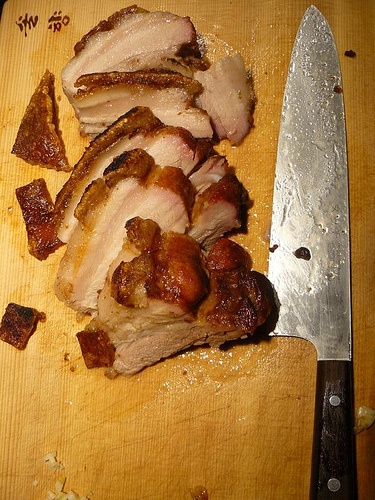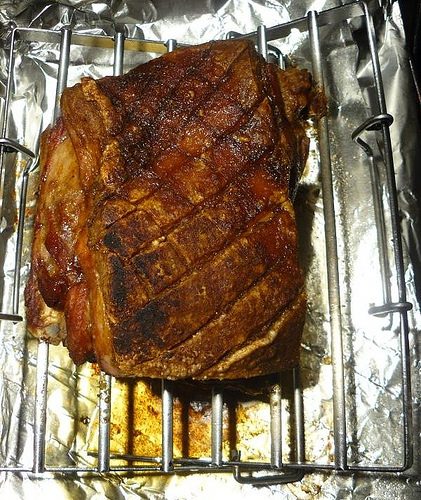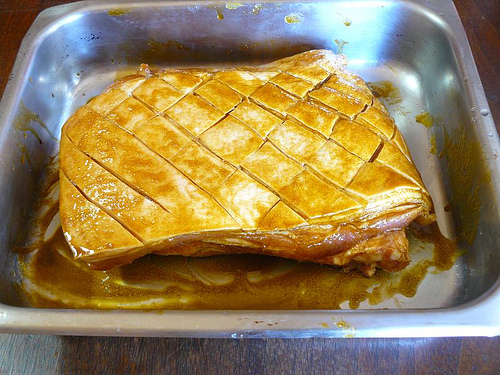
Some of my friends have said that they are “over” pork belly. How could one ever fall out of love with fat? That would could not happen to me. I recently slow cooked pork belly and now, with that cut of bone-in pork belly that I got from the Chinese market, I was going to try roasting it. I reached out for advice and suggestions on Facebook and this site included
- N. Fong: Yum! Marinate and slow braised, then roasted!
- J. Washburn: I get a chunk of bone-in pig belly nearly every time I go to Austin. It runs about $2.09/lb. there. Several ways to cook 'em. One of my favorites is rub with 5-spice, slow roast, run skin side under broiler to blister when done.
- J. Adams: Char siu!
See the comments section of the post on this unusual cut of pork to get Jarrett’s Thai take on Momofuku’s roast pork belly. Sunflower in the UK provided excellent information on a Chinese version of crisp pork belly.
Gazing at my bookshelves, I remembered seeing a recipe in Vietnamese-Australian Luke Nguyen’s The Songs of Sapa, a Vietnamese cookbook that’s up for an IACP cookbook award this year. I looked it up and his recipe intrigued me for the following reasons:
- It came from a Vietnamese vendor in Vietnam and Luke attached a great family story to the recipe. I'm a sucker for a good story, you know that!
- Required scalding the skin, which I just did for homemade Peking duck so I felt like I was on a roll.
- Involved these unusual ingredients: annatto oil, cornstarch, and baking soda. What do these ingredients do to the pork belly during roasting?
- Was very easy.
I wanted to keep things simple to allow the meat to shine. So I tried Luke's recipe out, and the results were good for my first time out with roasting bone-in pork belly. Pork in Vietnam often times requires scalding and scraping as it can be tough and needs to be cleaned – somewhat like scraping your tongue, which Asians have been doing since ancient times. Seriously.

The results from following Luke’s recipe for roast pork were these: The skin got nicely colored from the annatto oil and very crispy in certain parts, only after I ran it under broiler for the last 5 minutes or so, per the suggestion above. Slow roasting alone didn’t get the skin crisp. It was oddly kinda gummy in other areas that weren’t fully crisp, so I’m wondering if the cornstarch had an impact on turning the texture funny.
From the photo at the top, you can see that the flesh was exceptionally moist. The rib bones protected it in a way for the heat and added flavor too. I’m not sure about the baking soda as it is sometimes used in Vietnam as a meat tenderizer (!) and here it gave part of the roast an overly metallic taste that I didn’t care for.
But I had scaled up the recipe from Luke’s original quantities as I had a 3 pound roast whereas he called for a 2 ¼-pound roast. Sometimes scaling up a recipe takes it off its balance. All things considered, the final dip of the meat in some soy sauce and sliced chiles remedied everything. We ate half of the roast for dinner. We’re definitely not “over” pork belly!
RECIPE
Roast Pork
Heo Quay
This recipe is worth trying because it’s an intriguing method from Vietnam. (If you have Robert Danhi’s Southeast Asian Flavors cookbook, there’s another excellent Vietnamese vendor’s recipe for roasted pork belly.) In presenting this recipe from Luke Nguyen’s cookbook, I decided to leave the recipe as is because I’d like for you to interpret it too; the book is yet to be made available in the U.S. though you can order it online. Plus, there’s value in seeing how information is presented in other countries, should you be an American. My comments are in [brackets].
If you prepare The Song of Sapa’s roast pork, let the rest of us know your results! We’d love your thoughts!
Serves 4 to 6 as part of a shared meal
1 kg (2 lb 4 oz) pork belly, on the bone
1 teaspoon five-spice powder
2 tablespoons annatto oil (see below)
1 teaspoon bicarbonate of soda (baking soda)
2 teaspoons cornflour (cornstarch)
2 teaspoons sesame oil
1 bird’s eye chile, thinly sliced
Light (regular) soy sauce
1. Dip the skin of the pork belly briefly into boiled, hot water, taking care to keep the flesh out of the water. Clean the skin by scraping the surface with a knife to remove the outer layer; the skin should be a consistent white colour. Wash the skin, then, using a large, sharp knife, score the skin in either parallel lines or a crosshatch pattern. [If your pork skin is uniform white, maybe skip the scalding and scraping. See the photo caption below on my notes about scoring the skin.]
2. Combine ½ teaspoon of the five-spice, 1 tablespoon of the annatto oil, 1 teaspoon salt, the bicarbonate of soda and cornflour in a bowl, and mix well. Rub the mixture evenly over the pork skin.
 I decided to do some crosshatches and some parallel lines, each about ¾-inch apart.
I decided to do some crosshatches and some parallel lines, each about ¾-inch apart.The scoring actually made cutting the meat for serving easier. However the
skin fell off the fat, which is Peking duck-ish but not aesthetically pleasing.
I may have scored too deep.
3. In a separate bowl, combine the remaining five-spice, annatto oil and 1 teaspoon salt. Mix well, then coat the pork meat with the mixture, massaging it in well. Place the pork in a dish, cover with plastic wrap and place in the fridge for at least 6 hours, or overnight.
4. Preheat the oven to 250C (500F/Gas 9). Put the pork in a roasting tin, skin side up, and roast for 20 minutes, then reduce the heat to 150C (300F/Gas 2) and roast for a further 10 minutes. Brush the skin with the sesame oil and roast for a further 20 to 30 minutes, or until the pork is cooked through. [I would cook it for 30 to 40 more minutes, then turn on the broiler to crisp and blister the skin.]
5. Using a cleaver or large heavy knife, chop the pork belly into 2 cm (¾ inch) pieces. Serve with jasmine rice, and a small bowl of sliced chilli and soy sauce for dipping.
Note: Annatto seeds, also known as achiote, are used to add a golden colour to foods such as pork, chicken, or rice. Annatto seeds and oil are sold in Asian and Indian markets. If you can only find the seeds, these can be used to make the oil. Heat 1 tablespoon of annatto seeds in a saucepan over low heat with 125 ml (4 fl oz/1/2 cup) of oil. Heat just until the oil begins to simmer; don’t overheat or the seeds will turn black. Remove from the heat and set aside to cool, then strain the oil into a jar.
More pork belly recipes: (on my other site, Asiandumplingtips.com)

















Lewyintheuk says
Hi Andrea,
There was a piece in serious eats about oven-fried chicken wings where they compared using baking powder and baking soda to crisp and bubble the skin and settled on baking powder as it did not impart a metallic flavour. I haven't had a chance to try the method on pork belly yet but will be doing the following: rub a tsp of baking powder onto the skin and leave uncovered and skin side up in the fridge overnight. Score the skin, rub with peanut oil and five-spice powder (possibly some salt) and roast as per your directions. I'm hoping it will come out bubbly and crisp like sides I see hanging in the windows in chinatown!
Belinda @zomppa says
I'm with you - I'll never be over pork belly. Now I just have to wipe up this drool....
Andrea Nguyen says
Lewintheuk -- how interesting. I think you're on to something with replacing the baking soda with baking powder. For example if you use baking soda in steamed bao or even pancake batter, ewwww, you really taste it in a nasty way. What you're saying with your game plan sounds like a Peking duck approach of drying out the skin in the fridge. Sounds like a wise approach!
LookingForGoodFood says
I have tried both methods within the last few month, playing. (1) Baking soda leaves an after taste, which I do not much care for (2) Scalding and let it dry overnight in the refrigerator produces just as good of a result. (3) None of the recipe that I have tried have corn starch in it.
The key is in buying a good pork belly piece of meat. You want a piece that is from a young pig, the skin is thinner and thus it will produce a crispy piece of skin all the way through. If you buy a pork belly from an older pig, the skin is thicker, and thus, you really have to know your oven and play with how far you should
keep the pork skin away from the broil heating element to get a crispy skin all the way through without burning some of it.
Joel says
That looks nice Andrea! I read somewhere it is served with banh hoi as a Vietnamese wedding banquet dish, eh?
My Dad's wisdom on using the best piece of pork for Chinese siu yuk (that sunflower has provided) is more or less as LookingForGoodFood has said. He also said never select pork coming from boars unless they have been neutered, and ideally using the sow (female pigs). The gamey smell will ruin the dish, I heard. Second, choose a piece that has an evenly distributed fat and lean meat. (Although we never follow the talk ourselves and always ask vendors of cutting a leanest piece for us!)
Speaking of pork belly, I was reading Simon Gault's (One of the famous fine dining type chefs in NZ, a bit similar to Alfred Portale) books and he mentioned in his 2009 work "Nourish" that pork belly is currently one of these "in" cuts of meat on restaurant dining scenes in New Zealand among the general population. Meanwhile, the meat has never recovered from public perceptions about cholesterol and saturated fat over in East Asia like Hong Kong or Taiwan since the 1970s/80s. Even today, it carries a lot of stugma to order dishes such as "red cooked braised pork belly with taro" (nam yu kau yuk in Cantonese transliteration, or 荔芋扣肉) in Chinese restaurants in Hong Kong.
Andrea Nguyen says
@Lookingforgoodfood: What temperature do you roast your pork belly at? Love your insights on how to tell a young vs. old pig's belly. That's an invaluable tip!
@Joel: A lot of the upscale western restaurants selling pork belly these days may be reacting to economic times. Pork belly is rich and sinful and less expensive than filet. Asian people have either indulged in pork belly as a result of bad economic times (it's the most luxe tasting part of the pig) or good economic times (you can eat it as a novelty), pork belly has a different cultural meaning.
Indeed, for overseas/expat Viet people, there is a stigma to eating pork belly these days. Diabetes, cholesterol, high blood pressure -- well, one can either remember and dream or dabble in a little bit of pork belly now and then.
Jane says
Hi Andrea!
Would pork side be okay to use with this recipe?
Looks delicious!
Andrea Nguyen says
@Jane: Pork side is just the belly without the bones. Just cut down on the cooking time!
Ania says
Hi
May I just ask where in Vietnam did You purchase baking soda? I've looked in supermarkets but tehy don't sell any.
Supra Shoes says
My friends have time to go look
Supra Shoes says
Good job, buddy. Way to go! Congratulations!
New Jordans says
I shall remember that happiness day forever.
cheap supra shoes says
Thirdly, more and more Cameroonians find themselves in a comfortable arena when the two languages are invoked. Bilingualism has ceased to be a mere mention under the CPDM, but a resounding tool to boast of by many today.
pork belly recipes fan says
I wonder if placing a tray of water in the oven would give the top an even better texture. It would create steam in the oven and help keep the meat moist.
pork belly recipes fan says
I wonder if placing a tray of water in the oven would give the top an even better texture. It would create steam in the oven and help keep the meat moist.
Lynne says
Hi Andrea, I want to do some "nem chua", how do you do it? I love those thing but never know how to. And shish kabob? what kind of marinades or herbs do you use for this recipe? thanks alot.
Minh says
Thanks for You let't me kknow . Yes this will be ready for You in this afternoon. at 5 pm.When You come to my house finish the dinner then i will share with You how to make name chua ok. I love to hear from You. That food are so easy for me. Thanks agan.
Beats by Dr Dre says
A bold attempt is half success.
Canada Goose says
A good beginning is half the battle.
Warm Canada Goose says
Mishaps are like knives that either serve us or cut us as we grasp them by the handle or blade.
ann says
I tried making it with the baking powder instead of baking soda (I used the same amount as they ask for in baking soda). I must say I did not taste any metallic-ky flavor or anything like that. I think baking powder is definitely a winner!!!
Andrea Nguyen says
Thanks for sharing your experimentation results. Great tip on the baking powder!
marlon says
The key is in buying a good pork belly piece of meat. I love this recipre so much!
Binh says
Andrea, I recent visited this recipe again and decided to do it with only the seasoning. I find that the key to crispy skin is to make a lot of small punctures that break the skin -- I just use a sharp paring knife or a metal skewers and went to town. When roasting, the fat will bubble through and form blisters. Kinda like allowing it to deep fry in its own fat.
What I did was: season, rest, dry skin, score, puncture, cover skin with coarse salt, roast at low temp, remove and clean salt when crust forms, then dry skin again and put under broiler. The skin stays crispy even after refrigeration.
It's important to find a flat piece of pork belly so the skin cooks evenly. I stick skewers through the fat cap to keep it flat while cooking.
Thought I'd share my experience. Let me know if you have success doing same.